Under the Fir Tree: The Day of St. Claus
What kind of life would a dog have at the North Pole? What could a puppy do to help Santa? Under The Fir Tree: The Day of St. Claus (もみの木の下で The Day of St. Claus), an interactive storybook for Mac released in 1994, follows a small dog after they get stranded far from home and adopted by Santa.
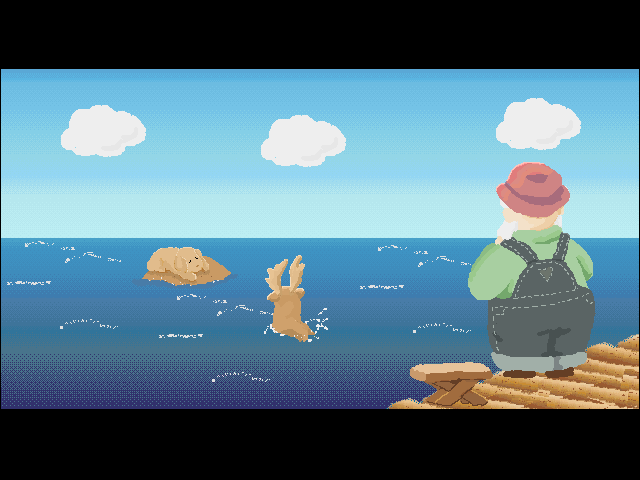
The Day of St. Claus opens with the dog and their relationship with a little girl. After she receives the dog for her birthday, they become fast friends—until a freak accident washes the dog off to sea one day. Luckily, they happen to come ashore in the North Pole at St. Town, the town where Santa and his single reindeer live. They rescue the little dog and take them in.
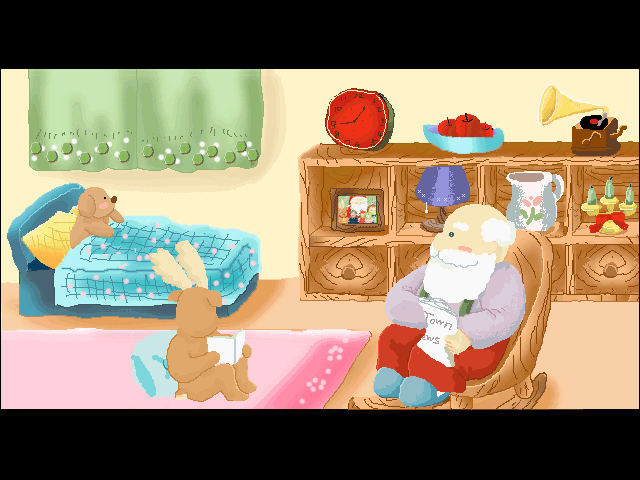
St. Claus is told entirely wordlessly aside from a minimal amount of text in the chapter title cards. Each scene is instead a little diorama, a partially-animated page showing a slice of the story with room for player interaction. As in most interactive storybooks, there are no branching pathways. Interaction reveals little extra details about the scene, cute easter eggs, or just small character moments that provide more characterization. It's nice when the player clicks and a fun thing happens; it's nice when you see a little more about a scene because you tried something. Sometimes these details are little sight gags, like witnessing a penguin steal from the reindeer's fish bucket; sometimes it provides extra characterizing details, like seeing St. Claus's family photos on his bookshelf and being able to imagine moments in his life.
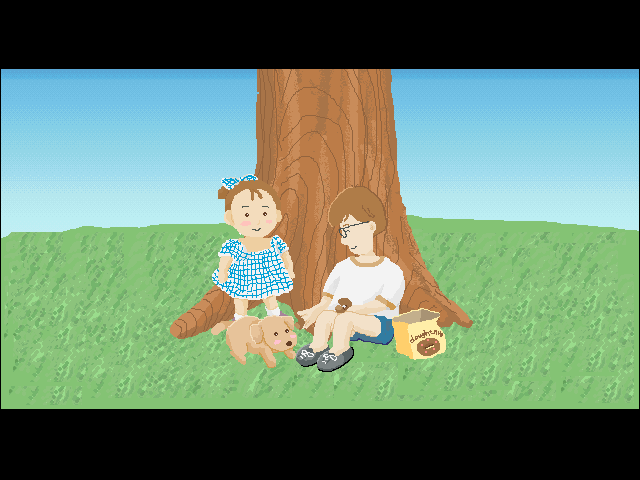
At first, the shape of the story seems fairly straightforward—dog gets lost, dog gets found by Santa, Santa delivers dog back home. It's a traditional Christmas storybook format. The really surprising part is how much of this story isn't devoted to that core premise, but instead setting up the dog's daily life in St. Town.
Despite the Christmassy trappings, most of the story isn't about Christmas at all. It's less a Christmas story and more a story that happens to be bookended by gift-giving celebrations. A significant amount of the runtime is devoted to the dog's first human friend, a little girl who hangs out in the field they like to play in. She develops a crush on an older boy, and experiences her first heartbreak when he graduates and moves to another town for his career. These aren't small moments, passed over quickly; it communicates the real sense that the dog has established a life here in St. Town, that they built a second home after losing their last one.
Most of the story takes place in the year leading up to Christmas, a time when nothing particularly Christmassey is on anyone's mind. We have a few scenes of St. Claus preparing presents, but it's clear that Christmas is only his and his reindeer's job. He doesn't live in the all-year Christmas industrial complex of Rankin/Bass's Rudolph or most other depictions of Christmas. St. Town might be named after Santa, but its residents have their own distinctly non-Christmassey lives and their own things to do. There are a few sprites and elves, but they're not Santa's helpers, just residents with their own concerns. When the little girl's crush prepares to head off to the real world after graduation, it's not in preparation for Christmas work of some kind, but for an entirely recognizable everyday life. That the dog has built a new life here is far more believable, and far more effective, when St. Town is just a place that exists and not a 24-hour Christmas zone that only exists in service to the world's children.
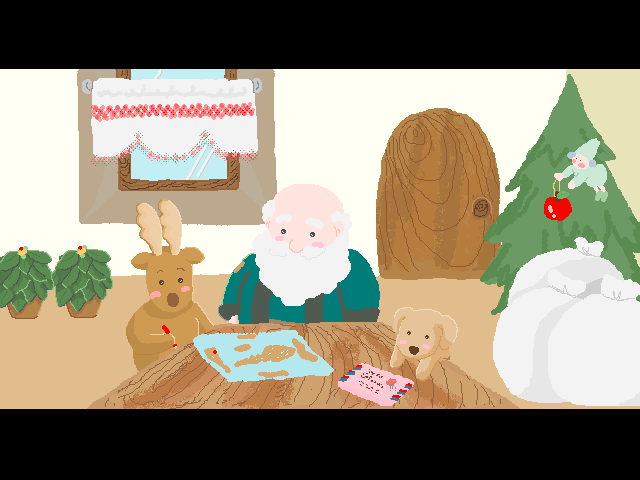
A significant amount of time is also given to the reindeer's budding relationship with the dog. The reindeer seems irritated with the dog's childlike mischief for a good part of the book, but as it develops there's a growing parental concern; the reindeer becomes protective, loving and genuinely caring towards them. By the end, when the puppy is finally returned home, it's hard for them to say goodbye—paralleling the earlier railroad departure of the student. This wasn't a short trip; the dog spent most of a year there with the reindeer, enough time to have started to build a life there before going back to his original home again. The reindeer's mixed feelings at saying goodbye also bookends the game's earlier scenes with a version for parents; where the girl's sorrow at losing her puppy and the other girl's sadness at her older crush moving away are a child's version of learning to cope with loss, the reindeer is an adult's sense of simultaneous pride and loss at seeing their child grow up and move in in life. The children reading this disc will have responded most strongly to the children's sense of loss, but the parent reading along will see themselves in the reindeer.
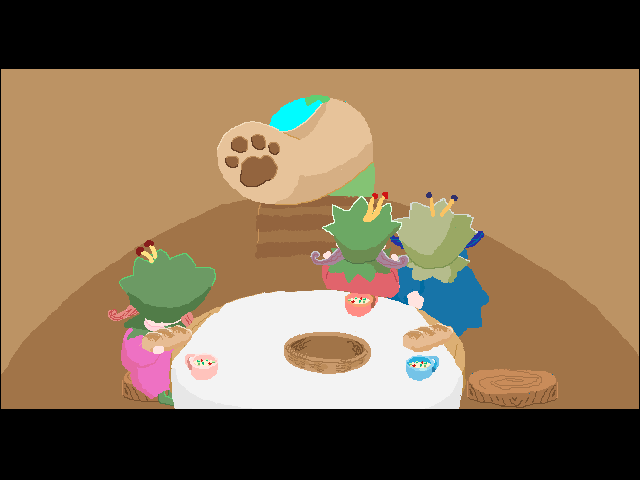
Both the art and story are the work of Kyoto-based artist Atsuko Hinata[1]. Her slightly crude, distinctly hand-drawn art style has been consistent throughout her career; the work shown on her website and her blog today is very clearly the work of the same person who drew St. Claus. The early part of her career involved work for CD-ROM publisher Taiyodo, who published St. Claus along with short works that appeared in their Uruuru CD-ROM compilation series. A significant part of her work has been character-focused, creating characters for use by companies like Yamaha and NEC BIGLOBE. More recently, she's focused on her singular love of dogs; her own profile, on her own website, devotes more time to biographies of her beloved pets than herself, and her personal blog showcases her original work for things like her local animal hospital's calendar[2].
According to the credits, Hinata was the sole artist responsible for this disc; she wasn't an art director, but truly illustrated every single page and every animation. That singular style shines through in every page; as much as a team of artists can recreate an individual's style, there's a particular energy that comes through when one artist is realizing their own work that's distinctly recognizable here. The art style has the slight crudeness of early digital work drawn directly on the computer, with slightly rough lines and a willingness to allow a natural wiggliness between frames. There are no straight lines, no regular shapes; everything has the distinct look of having been drawn by mouse and luxuriates in its irregularities. It's hard to say how it would have been received in its time, but in 2023 it gives a distinctly lo-fi, hand-drawn vibe in the same way that Ganbare! Inuchan and Amanda Stories do. It's a personal touch.

Aside from the artwork, the single largest chunk of the credits is devoted to music. St. Claus was composed by Shoichi Karasaki, a composer most known for his work on the stage[3]. His original score for St. Claus is pleasant, emotional without being cloying, and overall effective. It's also remarkably restrained; rather than the wall-to-wall music that many games use, it luxuriates in moments of silence, saving music for when it's needed and when it's effective.
Karasaki himself plays guitar and is joined by seven other musicians for the small live orchestra that performs it. The choice of an entirely live, non-synthesized soundtrack is surprising but effective; like the artwork, it gives a human touch to the story. As a theatre composer, Karasaki was well-suited to the role. This kind of small orchestra is the same scale as what a theatre production could afford, and let him make the most of his experience.
It's that combination of artistry and storytelling, with its willingness to spend time on the minutiae of their lives, that makes The Day of St. Claus so special. It could have been just another Christmas story, but it's the non-Christmas parts of the story that make it so charming and so special.
Under The Fir Tree: The Day of St. Claus is out of print and scarce, but copies are occasionally available second-hand. It runs well in the Mac emulators Basilisk II and SheepShaver as well as the software ScummVM.
1. Hinata-net『ひなたぼっこ』ぷろふぃーる. (n.d.). Retrieved December 18, 2023, from http://www.hinata-net.com/profile/ ↩
2. Hinata, A. (2023, November 11). 12日前. きょうのわんこずさま. http://wankos.blog84.fc2.com/blog-entry-3592.html ↩
3. からさきしょういち オフィシャルWEB. (n.d.). からさきしょういち オフィシャルWEB. Retrieved December 22, 2023, from http://s-karasaki.com/index.html ↩